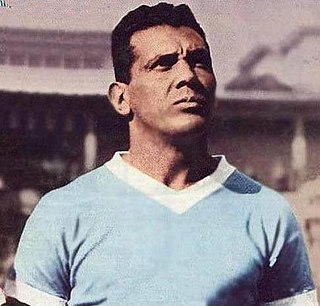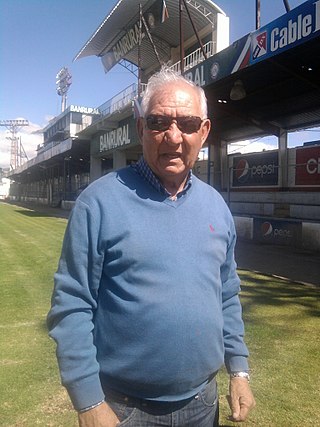Related Research Articles

Roque Gastón Máspoli Arbelvide was a Uruguayan football player and coach. He was the goalkeeper for the Uruguay national team that won the 1950 World Cup. He was also the head coach for the Uruguayan team that won the 1980 Mundialito.

Obdulio Jacinto Muiños Varela was a Uruguayan football player. He was the captain of the Uruguay national team that won the 1950 World Cup after beating Brazil in the decisive final round match popularly known as the Maracanazo. He was nicknamed "El Negro Jefe" because of his dark skin and the influence he had on the pitch, especially during the unlikely victory over Brazil. He was of African, Spanish and Greek ancestry. Commonly regarded as one of the greatest classic holding midfielders, Varela was adept in defence and was renowned for his tenacity and leadership. He is regarded as one of the greatest captains in football history, and "he remains one of the biggest sporting heroes in Uruguay".
The 1960 Copa de Campeones de América was the first season of the Copa CONMEBOL Libertadores, CONMEBOL's premier club tournament. Seven associations' clubs entered the first competition, with three not sending a representative. The first match of the tournament was played between Uruguayan side Peñarol and Bolivian side Jorge Wilstermann on April 19 in Montevideo, Uruguay.

Juan Eduardo Hohberg Roca was an Argentine-born Uruguayan football player and coach. He is best remembered as a player for Peñarol (1949–59) where he won 6 Uruguayan Primera División title wins, and for playing for Uruguay at the 1954 FIFA World Cup - where Uruguay finished 4th. He was also Manager (coach) of Uruguay at the 1970 World Cup - they finished 4th
Luis Bernardo Aguiar Burgos is an Uruguayan former professional footballer who played as an attacking midfielder.

Carlos Daniel Jurado Román was a Uruguayan football player and manager.
The 1966 Copa Libertadores de América was the seventh edition of the premier South American club football tournament, organized by CONMEBOL. Colombia and Brazil did not send their representatives. This edition became the first club competition of the world to include not just the champions but also the runners-up of each of its participating association. Despite the fact that Colombian and Brazilian clubs did not participate, this tournament saw a record 95 matches being played out to determine the year's champion.

Juan Joya Cordero was a Peruvian association football player, recognized as one of Peru's most important strikers. He was a historic forward of the Club Atlético Peñarol of Uruguay in the 1960s, one of the best South American teams of the twentieth century. During his time with Club Atlético Peñarol, he won 6 Uruguayan league championships, two Copa Libertadores, two Intercontinental Cups, and one Intercontinental Champions' Supercup. He was considered one of the best wingers in the world in the 1960s, and remains one of the most famous Peruvian footballers of all time.

Mauro Guevgeozián Crespo is a footballer who plays for La Luz FC. Born in Uruguay, he has represented the Armenia national football team.

Víctor Hugo Bagnulo Fernández was a Uruguayan football player and manager. He is most famous for his managing success at Uruguayan giants Peñarol, with whom he won five national league titles.
In the 2011–12 football season, the top league, Uruguayan Primera División, was won by Nacional. Progreso won the Segunda División and won promotion along with Central Español and Juventud. Three Uruguayan teams qualified for each of the 2011 Copa Sudamericana and 2012 Copa Libertadores. The national team played the first five of its qualifying matches for the 2014 FIFA World Cup, and took part in the 2011 Pan American Games, where the team lost to Argentina in the semifinal. National youth teams were also in action.
The Copa El Gráfico-Perú, was an international exhibition football competition hosted in Peru since 1999 until 2006. It features teams from Peru, Chile, Argentina and Uruguay. All matches are played at the Estadio Nacional in Lima.
Juan Martín Boselli Duque is an Uruguayan footballer who plays as a right winger for Spanish club Albacete Balompié, on loan from Peñarol.
Alejandro Hohberg González is a Peruvian football player who currently plays for Club Sporting Cristal.

Basilio Gabriel Costa Heredia is a professional footballer who plays as a midfielder for Peruvian Liga 1 club Universitario de Deportes. Born in Uruguay, Costa represents Peru internationally.
Gabriel Matías Fernández Leites, commonly known as "Toro Fernández", is a Uruguayan professional footballer who plays as a forward for Liga MX club Cruz Azul.
José Mauricio Larriera Dibarboure is a Uruguayan football manager and former player who played as a right-back.
The following squads were named for the 1942 South American Championship that took place in Uruguay.
The 2022 Copa Uruguay, was the inaugural edition of the Copa Uruguay, the country's national football cup tournament. The tournament began on 22 June and ended on 13 November, and had 76 teams participating.
The 2023 Copa Uruguay, was the second edition of the Copa Uruguay, the country's national football cup tournament. The tournament began on 21 August 2023 and had 80 teams participating. It was originally scheduled to end on 10 December 2023, but the tournament was paused at the round of 16 and resumed on 5 February 2024 due to a players strike in Uruguayan football, with the final match eventually moved to 22 May 2024.
References
- 1 2 3 4 5 Manya de pura cepa, elobservador.com.uy, 14 July 2013
- ↑ Manya de pura cepa, aurinegromundo.blogspot.com, 15 July 2013
- ↑ "Gabriel Leyes: de darle un título a Alianza Lima a fichar por humilde club de Perú" [Gabriel Leyes: from giving Alianza Lima a title to signing for a humble club in Peru]. Líbero (in Spanish). 3 January 2023. Retrieved 11 February 2023.